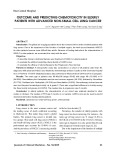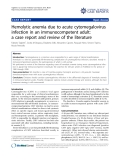
Anemia due
-
The global rise in aging population led to the increase of the number of elderly patients with lung cancer. Due to the impairment of the function of multiple organs, the work-up and treatment NSCLC for older patients become more difficult than adults.
 5p
5p  vinatisu
vinatisu
 29-08-2024
29-08-2024
 5
5
 1
1
 Download
Download
-
Tuyển tập báo cáo các nghiên cứu khoa học quốc tế ngành y học dành cho các bạn tham khảo đề tài: Hemolytic anemia due to acute cytomegalovirus infection in an immunocompetent adult: a case report and review of the literature
 3p
3p  toshiba25
toshiba25
 09-12-2011
09-12-2011
 55
55
 6
6
 Download
Download
-
Chronic Idiopathic Myelofibrosis: Treatment No specific therapy exists for chronic IMF. Anemia may be due to gastrointestinal blood loss and exacerbated by folic acid deficiency, and in rare instances, pyridoxine therapy has been effective. However, anemia is more often due to ineffective erythropoiesis uncompensated by extramedullary hematopoiesis in the spleen and liver. Neither recombinant erythropoietin nor androgens, such as Danazol, have proved consistently effective as therapy for anemia.
 5p
5p  thanhongan
thanhongan
 07-12-2010
07-12-2010
 72
72
 3
3
 Download
Download
-
Thrombotic Thrombocytopenic Purpura TTP and HUS were previously considered overlap syndromes. However, in the past few years the pathophysiology of inherited and idiopathic TTP has become better understood and clearly differs from HUS. TTP was first described in 1924 by Eli Moschcowitz and characterized by a pentad of findings that include microangiopathic hemolytic anemia, thrombocytopenia, renal failure, neurologic findings, and fever. The full-blown syndrome is less commonly seen now, probably due to earlier diagnosis.
 5p
5p  thanhongan
thanhongan
 07-12-2010
07-12-2010
 78
78
 3
3
 Download
Download
-
Anemia occurs in ~80% of myeloma patients. It is usually normocytic and normochromic and related both to the replacement of normal marrow by expanding tumor cells and to the inhibition of hematopoiesis by factors made by the tumor. In addition, mild hemolysis may contribute to the anemia. A larger than expected fraction of patients may have megaloblastic anemia due to either folate or vitamin B12 deficiency. Granulocytopenia and thrombocytopenia are very rare.
 7p
7p  thanhongan
thanhongan
 07-12-2010
07-12-2010
 83
83
 7
7
 Download
Download
-
Persistent Parvovirus B19 Infection Chronic parvovirus infection is an important, treatable cause of PRCA. This common virus causes a benign exanthem of childhood (fifth disease) and a polyarthralgia/arthritis syndrome in adults. In patients with underlying hemolysis (or any condition that increases demand for red blood cell production), parvovirus infection can cause a transient aplastic crisis and an abrupt but temporary worsening of the anemia due to failed erythropoiesis.
 5p
5p  thanhongan
thanhongan
 07-12-2010
07-12-2010
 61
61
 5
5
 Download
Download
-
Definition and Differential Diagnosis PRCA is characterized by anemia, reticulocytopenia, and absent or rare erythroid precursor cells in the bone marrow. The classification of PRCA is shown in Table 102-4. In adults, PRCA is acquired. An identical syndrome can occur constitutionally: Diamond-Blackfan anemia, or congenital PRCA, is diagnosed at birth or in early childhood and often responds to glucocorticoid treatment; a minority of patients have etiologic mutations in a ribosomal RNA processing gene called RPS19.
 5p
5p  thanhongan
thanhongan
 07-12-2010
07-12-2010
 76
76
 4
4
 Download
Download
-
Anemia Due to Acute Blood Loss Blood loss causes anemia by two main mechanisms: first, by the direct loss of red cells; second, because if the loss of blood is protracted, it will gradually deplete the iron stores, eventually resulting in iron deficiency. Iron-deficiency anemia is discussed in Chap. 98. Here we are concerned with post-hemorrhagic anemia, which follows acute blood loss. This can be external (as after trauma or due to postpartum hemorrhage) or internal (e.g., from bleeding in the gastrointestinal tract, rupture of the spleen, rupture of an ectopic pregnancy).
 5p
5p  thanhongan
thanhongan
 07-12-2010
07-12-2010
 80
80
 6
6
 Download
Download
-
Infections Hepatitis is the most common preceding infection, and posthepatitis marrow failure accounts for about 5% of etiologies in most series. Patients are usually young men who have recovered from a bout of liver inflammation 1 to 2 months earlier; the subsequent pancytopenia is very severe. The hepatitis is seronegative (non-A, non-B, non-C, non-G) and possibly due to a novel, as yet undiscovered, virus. Fulminant liver failure in childhood also follows seronegative hepatitis, and marrow failure occurs at a high rate in these patients.
 5p
5p  thanhongan
thanhongan
 07-12-2010
07-12-2010
 75
75
 4
4
 Download
Download
-
Pyrimidine 5'-Nucleotidase (P5N) Deficiency P5N is a key enzyme in the catabolism of nucleotides arising from the degradation of nucleic acids that takes place in the final stages of red cell maturation. How exactly its deficiency causes HA is not well understood, but a highly distinctive feature of this condition is a morphologic abnormality of the red cells known as basophilic stippling. The condition is rare, but it probably ranks third in frequency among red cell enzyme defects (after G6PD deficiency and PK deficiency).
 5p
5p  thanhongan
thanhongan
 07-12-2010
07-12-2010
 68
68
 4
4
 Download
Download
-
Autoimmune Hemolytic Anemia (AIHA) Except for countries where malaria is endemic, AIHA is the most common form of acquired hemolytic anemia. In fact, not quite appropriately, the two phrases are sometimes used synonymously. Pathophysiology AIHA is caused by an autoantibody directed against a red cell antigen, i.e., a molecule present on the surface of red cells. The autoantibody binds to the red cells. Once a red cell is coated by antibody, it will be destroyed by one or more mechanisms.
 5p
5p  thanhongan
thanhongan
 07-12-2010
07-12-2010
 69
69
 4
4
 Download
Download
-
Severe acute AIHA can be a medical emergency. The immediate treatment almost invariably includes transfusion of red cells. This may pose a special problem because if the antibody involved is "unspecific," all the blood units crossmatched will be incompatible. In these cases it is often correct, paradoxically, to transfuse incompatible blood, the rationale being that the transfused red cells will be destroyed no less but no more than the patient's own red cells, and in the meantime the patient stays alive.
 5p
5p  thanhongan
thanhongan
 07-12-2010
07-12-2010
 63
63
 4
4
 Download
Download
-
PNH has about the same frequency in men and women, and it is encountered in all populations throughout the world, but it is a rare disease: its prevalence is 1–5 per million (it may be somewhat less rare in Southeast Asia and in the Far East). There is no evidence of inherited susceptibility. PNH has never been reported as a congenital disease, but it can present in small children or in people in their seventies, although most patients are young adults. Clinical Features The patient may seek medical attention because one morning she or he has passed "blood instead of urine."...
 5p
5p  thanhongan
thanhongan
 07-12-2010
07-12-2010
 72
72
 4
4
 Download
Download
-
Bone Marrow Failure—Relationship between PNH and AA It is not unusual that patients with firmly established PNH have a previous history of well-documented AA. On the other hand, sometimes a patient with PNH becomes less hemolytic and more pancytopenic and ultimately has the clinical picture of AA. Since AA is probably an organ-specific autoimmune disease in which T cells cause damage to hematopoietic stem cells, the same may be true of PNH, with the specific proviso that the damage spares PNH stem cells. Skewing of the T cell repertoire in patients with PNH supports this notion.
 5p
5p  thanhongan
thanhongan
 07-12-2010
07-12-2010
 73
73
 4
4
 Download
Download
-
Table 101-5 Drugs that Carry Risk of Clinical Hemolysis in Persons with G6PD Deficiency Definite Risk Risk Possible Risk Doubtful Antimalarials Primaquine uine Chloroq Quinine Dapsone/chlorp roguanil Sulphonamides/s ulphones ole Sulphametoxaz zine Sulfasala ole Sulfisoxaz Others idine Sulfadim ne Sulfadiazi Dapsone Antibacterial/anti biotics Cotrimoxazole xacin Ciproflo Chloramp henicol Nalidixic acid cin Norfloxa pAminosalicylic acid Nitrofurantoin Niridazole Antipyretic/analg esics Acetanilide Acetylsa Acetylsali licylic acid high cylic acid 3 g/d) Phena...
 6p
6p  thanhongan
thanhongan
 07-12-2010
07-12-2010
 71
71
 4
4
 Download
Download
-
Figure 101-6 Peripheral blood smear from a 5-year-old G6PD-deficient boy with acute favism. A very small minority of subjects with G6PD deficiency have CNSHA of variable severity. The patient is always a male, usually with a history of NNJ, who may present with anemia or unexplained jaundice, or because of gallstones later in life. The spleen may be enlarged. The severity of anemia ranges from borderline to transfusion-dependent. The anemia is usually normo-macrocytic, with reticulocytosis. Bilirubin and LDH are increased.
 5p
5p  thanhongan
thanhongan
 07-12-2010
07-12-2010
 128
128
 4
4
 Download
Download
-
Abnormalities of the Glycolytic Pathway (Fig. 101-1) Since red cells, in the course of their differentiation, have sacrificed not only their nucleus and their ribosomes but also their mitochondria, they rely exclusively on the anaerobic portion of the glycolytic pathway for producing energy in the form of ATP. Most of the ATP is required by the red cell for cation transport against a concentration gradient across the membrane. If this fails, due to a defect of any of the enzymes of the glycolytic pathway, the result will be hemolytic disease.
 6p
6p  thanhongan
thanhongan
 07-12-2010
07-12-2010
 91
91
 5
5
 Download
Download
-
Clinical Presentation and Diagnosis The spectrum of clinical severity of HS is broad. Severe cases may present in infancy with severe anemia, whereas mild cases may present in young adults or even later in life. In women, HS is sometimes first diagnosed when anemia is investigated during pregnancy. The main clinical findings are jaundice, an enlarged spleen, and often gallstones; frequently it is the finding of gallstones in a young person that triggers diagnostic investigations.
 5p
5p  thanhongan
thanhongan
 07-12-2010
07-12-2010
 89
89
 4
4
 Download
Download
-
Pyruvate Kinase Deficiency: Treatment Management of PK deficiency is mainly supportive. In view of the marked increase in red cell turnover, oral folic acid supplements should be given constantly. Blood transfusion should be used as necessary, and iron chelation may have to be added if the blood transfusion requirement is high enough to cause iron overload. In these patients, who have more severe disease, splenectomy may be beneficial.
 5p
5p  thanhongan
thanhongan
 07-12-2010
07-12-2010
 69
69
 4
4
 Download
Download
-
Epidemiology G6PD deficiency is widely distributed in tropical and subtropical parts of the world (Africa, Southern Europe, the Middle East, Southeast Asia, and Oceania) (Fig. 101-5) and wherever people from those areas have migrated; a conservative estimate is that at least 400 million people have a G6PD-deficiency gene. In several of these areas, the frequency of a G6PD-deficiency gene may be as high as 20% or more.
 5p
5p  thanhongan
thanhongan
 07-12-2010
07-12-2010
 78
78
 4
4
 Download
Download
CHỦ ĐỀ BẠN MUỐN TÌM
































